Developing a Framework for Critiquing Honey in Wound Healing Research
VerifiedAdded on 2023/01/10
|10
|3224
|33
Report
AI Summary
This report critically examines the use of medical-grade honey for wound healing, focusing on an article exploring older patients' experiences and perceptions. It utilizes the Caldwell critiquing tool to assess both quantitative and qualitative aspects of the research, emphasizing evidence-based practice. The report highlights the complexities of honey treatment, comparing it to antimicrobial wound dressings and analyzing the rationale for rediscovering ancient remedies like honey. It details the framework for critiquing the research, including data collection, analysis, and findings, and evaluates the study's methodology and ethical considerations. The report also explores the use of Interpretative Phenomenological Analysis (IPA) and the benefits of honey for healing different wounds, providing a deep insight into the patient's experience. It concludes by emphasizing the importance of understanding both the benefits and potential drawbacks of honey as a treatment option.
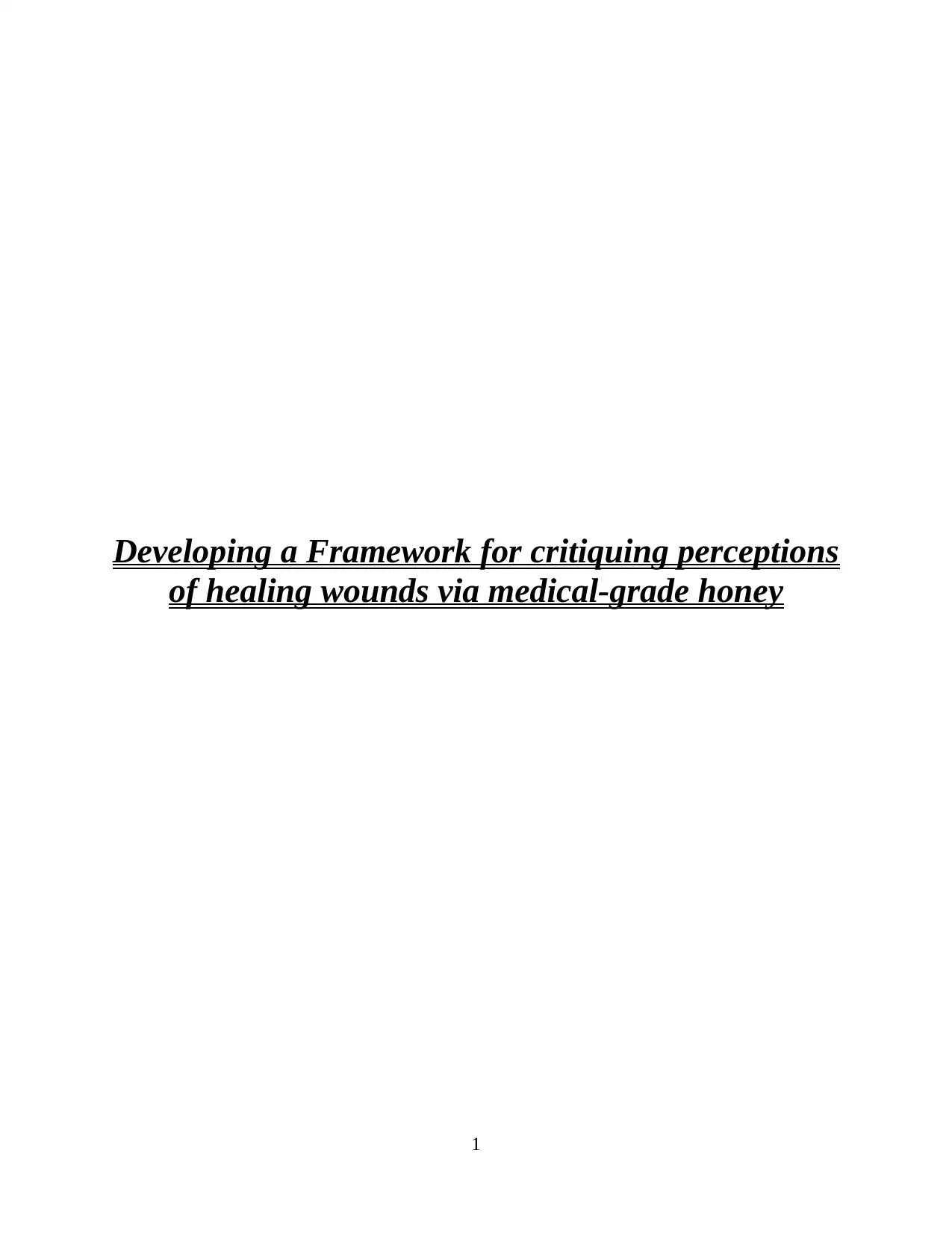
Developing a Framework for critiquing perceptions
of healing wounds via medical-grade honey
1
of healing wounds via medical-grade honey
1
Paraphrase This Document
Need a fresh take? Get an instant paraphrase of this document with our AI Paraphraser
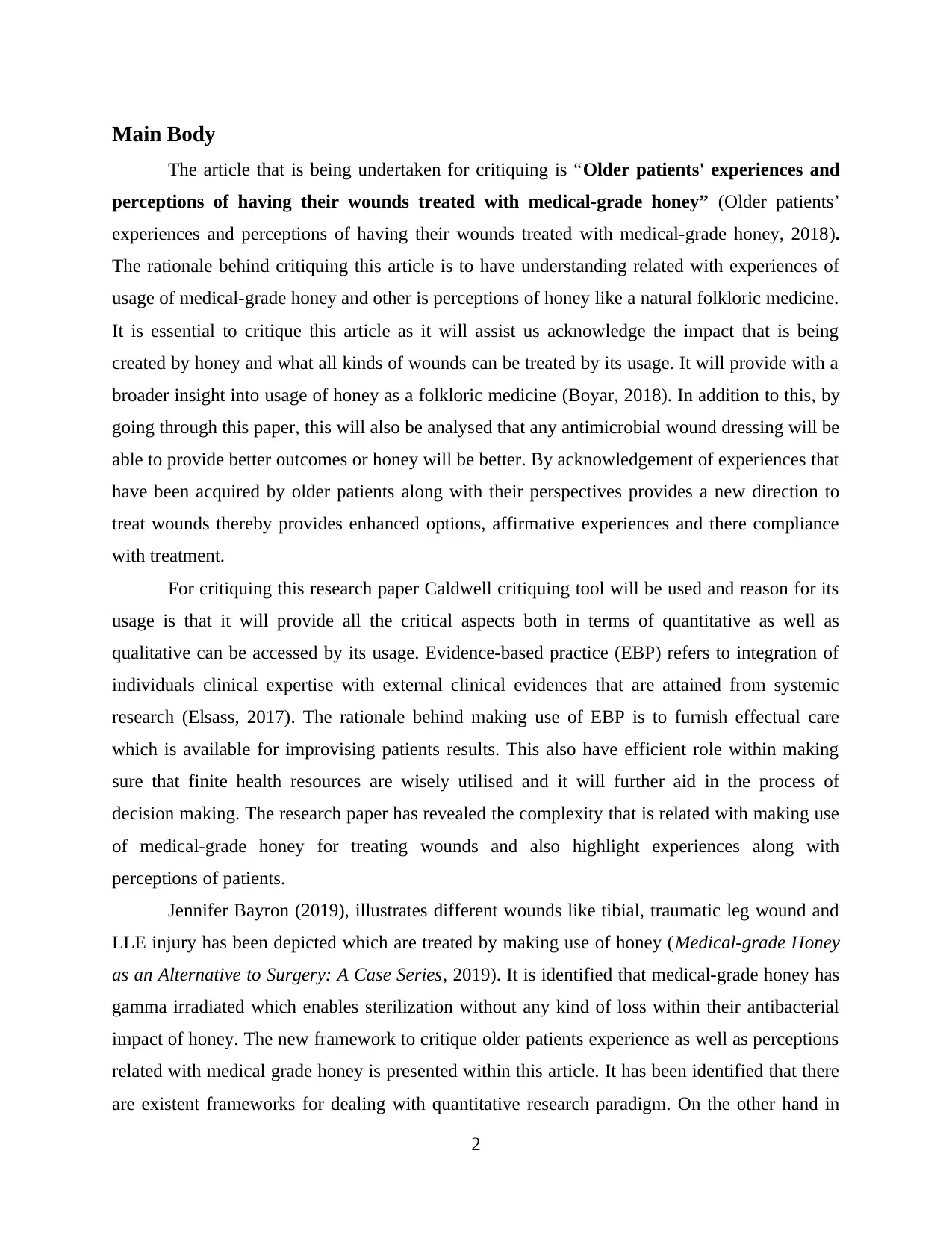
Main Body
The article that is being undertaken for critiquing is “Older patients' experiences and
perceptions of having their wounds treated with medical-grade honey” (Older patients’
experiences and perceptions of having their wounds treated with medical-grade honey, 2018).
The rationale behind critiquing this article is to have understanding related with experiences of
usage of medical-grade honey and other is perceptions of honey like a natural folkloric medicine.
It is essential to critique this article as it will assist us acknowledge the impact that is being
created by honey and what all kinds of wounds can be treated by its usage. It will provide with a
broader insight into usage of honey as a folkloric medicine (Boyar, 2018). In addition to this, by
going through this paper, this will also be analysed that any antimicrobial wound dressing will be
able to provide better outcomes or honey will be better. By acknowledgement of experiences that
have been acquired by older patients along with their perspectives provides a new direction to
treat wounds thereby provides enhanced options, affirmative experiences and there compliance
with treatment.
For critiquing this research paper Caldwell critiquing tool will be used and reason for its
usage is that it will provide all the critical aspects both in terms of quantitative as well as
qualitative can be accessed by its usage. Evidence-based practice (EBP) refers to integration of
individuals clinical expertise with external clinical evidences that are attained from systemic
research (Elsass, 2017). The rationale behind making use of EBP is to furnish effectual care
which is available for improvising patients results. This also have efficient role within making
sure that finite health resources are wisely utilised and it will further aid in the process of
decision making. The research paper has revealed the complexity that is related with making use
of medical-grade honey for treating wounds and also highlight experiences along with
perceptions of patients.
Jennifer Bayron (2019), illustrates different wounds like tibial, traumatic leg wound and
LLE injury has been depicted which are treated by making use of honey (Medical-grade Honey
as an Alternative to Surgery: A Case Series, 2019). It is identified that medical-grade honey has
gamma irradiated which enables sterilization without any kind of loss within their antibacterial
impact of honey. The new framework to critique older patients experience as well as perceptions
related with medical grade honey is presented within this article. It has been identified that there
are existent frameworks for dealing with quantitative research paradigm. On the other hand in
2
The article that is being undertaken for critiquing is “Older patients' experiences and
perceptions of having their wounds treated with medical-grade honey” (Older patients’
experiences and perceptions of having their wounds treated with medical-grade honey, 2018).
The rationale behind critiquing this article is to have understanding related with experiences of
usage of medical-grade honey and other is perceptions of honey like a natural folkloric medicine.
It is essential to critique this article as it will assist us acknowledge the impact that is being
created by honey and what all kinds of wounds can be treated by its usage. It will provide with a
broader insight into usage of honey as a folkloric medicine (Boyar, 2018). In addition to this, by
going through this paper, this will also be analysed that any antimicrobial wound dressing will be
able to provide better outcomes or honey will be better. By acknowledgement of experiences that
have been acquired by older patients along with their perspectives provides a new direction to
treat wounds thereby provides enhanced options, affirmative experiences and there compliance
with treatment.
For critiquing this research paper Caldwell critiquing tool will be used and reason for its
usage is that it will provide all the critical aspects both in terms of quantitative as well as
qualitative can be accessed by its usage. Evidence-based practice (EBP) refers to integration of
individuals clinical expertise with external clinical evidences that are attained from systemic
research (Elsass, 2017). The rationale behind making use of EBP is to furnish effectual care
which is available for improvising patients results. This also have efficient role within making
sure that finite health resources are wisely utilised and it will further aid in the process of
decision making. The research paper has revealed the complexity that is related with making use
of medical-grade honey for treating wounds and also highlight experiences along with
perceptions of patients.
Jennifer Bayron (2019), illustrates different wounds like tibial, traumatic leg wound and
LLE injury has been depicted which are treated by making use of honey (Medical-grade Honey
as an Alternative to Surgery: A Case Series, 2019). It is identified that medical-grade honey has
gamma irradiated which enables sterilization without any kind of loss within their antibacterial
impact of honey. The new framework to critique older patients experience as well as perceptions
related with medical grade honey is presented within this article. It has been identified that there
are existent frameworks for dealing with quantitative research paradigm. On the other hand in
2
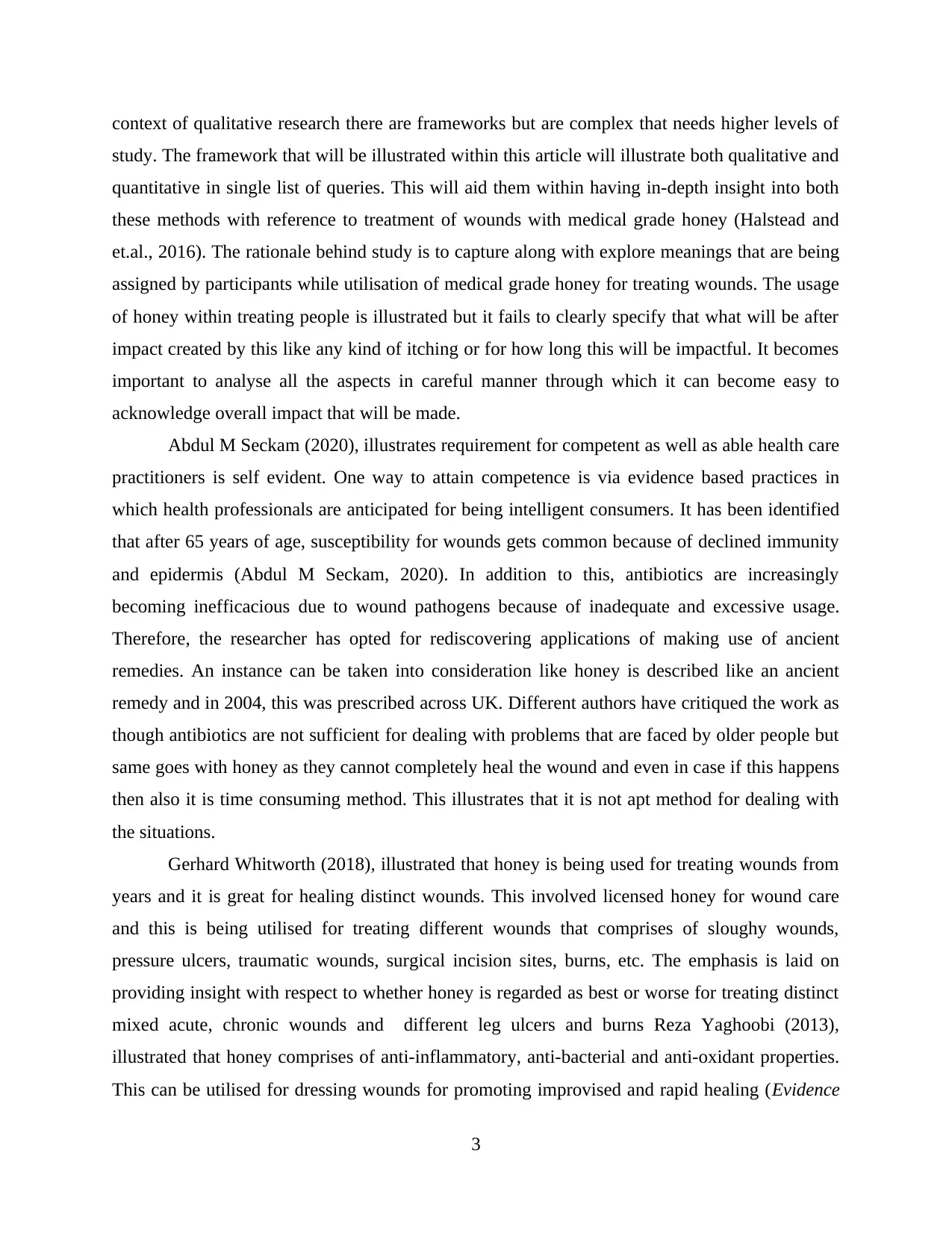
context of qualitative research there are frameworks but are complex that needs higher levels of
study. The framework that will be illustrated within this article will illustrate both qualitative and
quantitative in single list of queries. This will aid them within having in-depth insight into both
these methods with reference to treatment of wounds with medical grade honey (Halstead and
et.al., 2016). The rationale behind study is to capture along with explore meanings that are being
assigned by participants while utilisation of medical grade honey for treating wounds. The usage
of honey within treating people is illustrated but it fails to clearly specify that what will be after
impact created by this like any kind of itching or for how long this will be impactful. It becomes
important to analyse all the aspects in careful manner through which it can become easy to
acknowledge overall impact that will be made.
Abdul M Seckam (2020), illustrates requirement for competent as well as able health care
practitioners is self evident. One way to attain competence is via evidence based practices in
which health professionals are anticipated for being intelligent consumers. It has been identified
that after 65 years of age, susceptibility for wounds gets common because of declined immunity
and epidermis (Abdul M Seckam, 2020). In addition to this, antibiotics are increasingly
becoming inefficacious due to wound pathogens because of inadequate and excessive usage.
Therefore, the researcher has opted for rediscovering applications of making use of ancient
remedies. An instance can be taken into consideration like honey is described like an ancient
remedy and in 2004, this was prescribed across UK. Different authors have critiqued the work as
though antibiotics are not sufficient for dealing with problems that are faced by older people but
same goes with honey as they cannot completely heal the wound and even in case if this happens
then also it is time consuming method. This illustrates that it is not apt method for dealing with
the situations.
Gerhard Whitworth (2018), illustrated that honey is being used for treating wounds from
years and it is great for healing distinct wounds. This involved licensed honey for wound care
and this is being utilised for treating different wounds that comprises of sloughy wounds,
pressure ulcers, traumatic wounds, surgical incision sites, burns, etc. The emphasis is laid on
providing insight with respect to whether honey is regarded as best or worse for treating distinct
mixed acute, chronic wounds and different leg ulcers and burns Reza Yaghoobi (2013),
illustrated that honey comprises of anti-inflammatory, anti-bacterial and anti-oxidant properties.
This can be utilised for dressing wounds for promoting improvised and rapid healing (Evidence
3
study. The framework that will be illustrated within this article will illustrate both qualitative and
quantitative in single list of queries. This will aid them within having in-depth insight into both
these methods with reference to treatment of wounds with medical grade honey (Halstead and
et.al., 2016). The rationale behind study is to capture along with explore meanings that are being
assigned by participants while utilisation of medical grade honey for treating wounds. The usage
of honey within treating people is illustrated but it fails to clearly specify that what will be after
impact created by this like any kind of itching or for how long this will be impactful. It becomes
important to analyse all the aspects in careful manner through which it can become easy to
acknowledge overall impact that will be made.
Abdul M Seckam (2020), illustrates requirement for competent as well as able health care
practitioners is self evident. One way to attain competence is via evidence based practices in
which health professionals are anticipated for being intelligent consumers. It has been identified
that after 65 years of age, susceptibility for wounds gets common because of declined immunity
and epidermis (Abdul M Seckam, 2020). In addition to this, antibiotics are increasingly
becoming inefficacious due to wound pathogens because of inadequate and excessive usage.
Therefore, the researcher has opted for rediscovering applications of making use of ancient
remedies. An instance can be taken into consideration like honey is described like an ancient
remedy and in 2004, this was prescribed across UK. Different authors have critiqued the work as
though antibiotics are not sufficient for dealing with problems that are faced by older people but
same goes with honey as they cannot completely heal the wound and even in case if this happens
then also it is time consuming method. This illustrates that it is not apt method for dealing with
the situations.
Gerhard Whitworth (2018), illustrated that honey is being used for treating wounds from
years and it is great for healing distinct wounds. This involved licensed honey for wound care
and this is being utilised for treating different wounds that comprises of sloughy wounds,
pressure ulcers, traumatic wounds, surgical incision sites, burns, etc. The emphasis is laid on
providing insight with respect to whether honey is regarded as best or worse for treating distinct
mixed acute, chronic wounds and different leg ulcers and burns Reza Yaghoobi (2013),
illustrated that honey comprises of anti-inflammatory, anti-bacterial and anti-oxidant properties.
This can be utilised for dressing wounds for promoting improvised and rapid healing (Evidence
3
⊘ This is a preview!⊘
Do you want full access?
Subscribe today to unlock all pages.

Trusted by 1+ million students worldwide
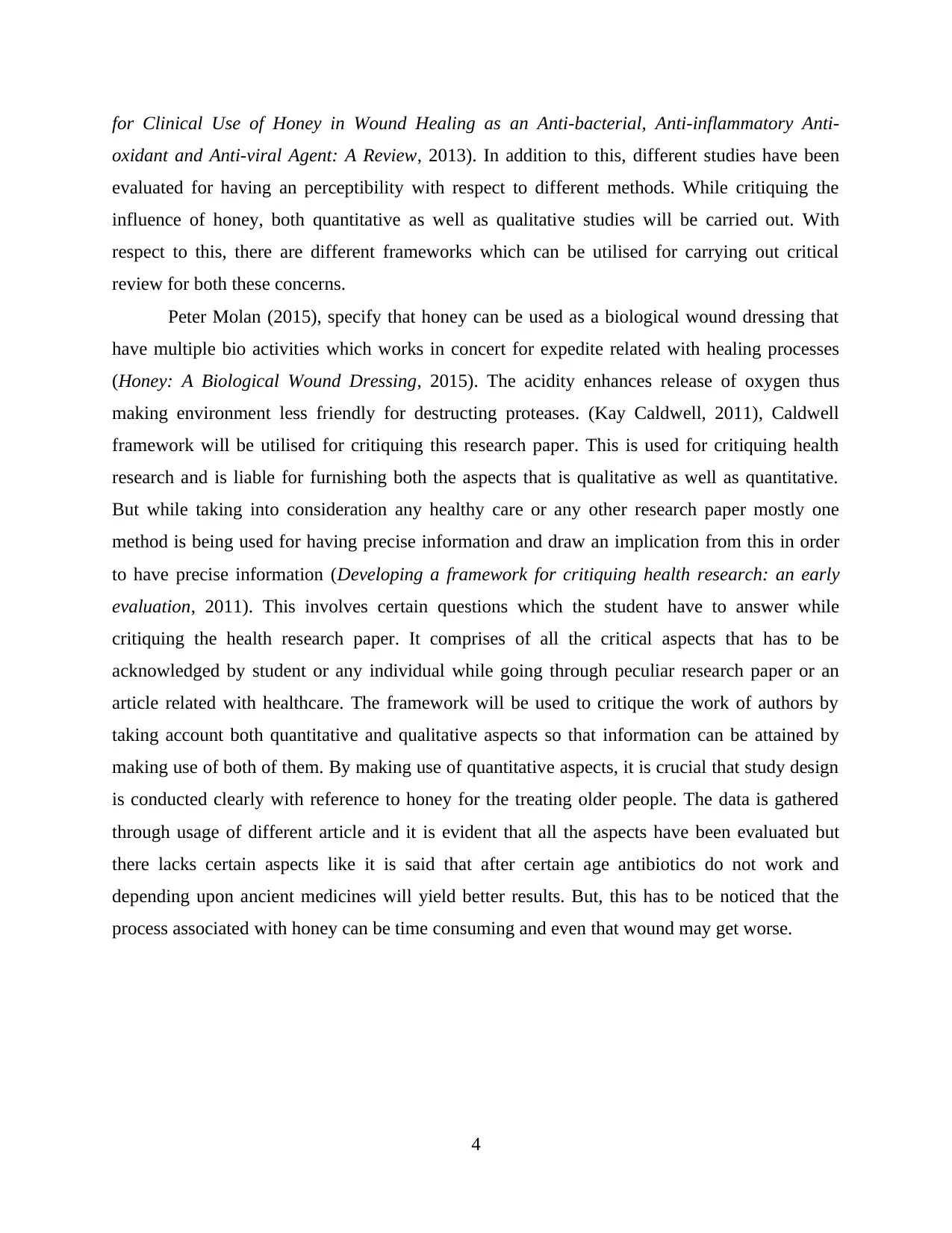
for Clinical Use of Honey in Wound Healing as an Anti-bacterial, Anti-inflammatory Anti-
oxidant and Anti-viral Agent: A Review, 2013). In addition to this, different studies have been
evaluated for having an perceptibility with respect to different methods. While critiquing the
influence of honey, both quantitative as well as qualitative studies will be carried out. With
respect to this, there are different frameworks which can be utilised for carrying out critical
review for both these concerns.
Peter Molan (2015), specify that honey can be used as a biological wound dressing that
have multiple bio activities which works in concert for expedite related with healing processes
(Honey: A Biological Wound Dressing, 2015). The acidity enhances release of oxygen thus
making environment less friendly for destructing proteases. (Kay Caldwell, 2011), Caldwell
framework will be utilised for critiquing this research paper. This is used for critiquing health
research and is liable for furnishing both the aspects that is qualitative as well as quantitative.
But while taking into consideration any healthy care or any other research paper mostly one
method is being used for having precise information and draw an implication from this in order
to have precise information (Developing a framework for critiquing health research: an early
evaluation, 2011). This involves certain questions which the student have to answer while
critiquing the health research paper. It comprises of all the critical aspects that has to be
acknowledged by student or any individual while going through peculiar research paper or an
article related with healthcare. The framework will be used to critique the work of authors by
taking account both quantitative and qualitative aspects so that information can be attained by
making use of both of them. By making use of quantitative aspects, it is crucial that study design
is conducted clearly with reference to honey for the treating older people. The data is gathered
through usage of different article and it is evident that all the aspects have been evaluated but
there lacks certain aspects like it is said that after certain age antibiotics do not work and
depending upon ancient medicines will yield better results. But, this has to be noticed that the
process associated with honey can be time consuming and even that wound may get worse.
4
oxidant and Anti-viral Agent: A Review, 2013). In addition to this, different studies have been
evaluated for having an perceptibility with respect to different methods. While critiquing the
influence of honey, both quantitative as well as qualitative studies will be carried out. With
respect to this, there are different frameworks which can be utilised for carrying out critical
review for both these concerns.
Peter Molan (2015), specify that honey can be used as a biological wound dressing that
have multiple bio activities which works in concert for expedite related with healing processes
(Honey: A Biological Wound Dressing, 2015). The acidity enhances release of oxygen thus
making environment less friendly for destructing proteases. (Kay Caldwell, 2011), Caldwell
framework will be utilised for critiquing this research paper. This is used for critiquing health
research and is liable for furnishing both the aspects that is qualitative as well as quantitative.
But while taking into consideration any healthy care or any other research paper mostly one
method is being used for having precise information and draw an implication from this in order
to have precise information (Developing a framework for critiquing health research: an early
evaluation, 2011). This involves certain questions which the student have to answer while
critiquing the health research paper. It comprises of all the critical aspects that has to be
acknowledged by student or any individual while going through peculiar research paper or an
article related with healthcare. The framework will be used to critique the work of authors by
taking account both quantitative and qualitative aspects so that information can be attained by
making use of both of them. By making use of quantitative aspects, it is crucial that study design
is conducted clearly with reference to honey for the treating older people. The data is gathered
through usage of different article and it is evident that all the aspects have been evaluated but
there lacks certain aspects like it is said that after certain age antibiotics do not work and
depending upon ancient medicines will yield better results. But, this has to be noticed that the
process associated with honey can be time consuming and even that wound may get worse.
4
Paraphrase This Document
Need a fresh take? Get an instant paraphrase of this document with our AI Paraphraser
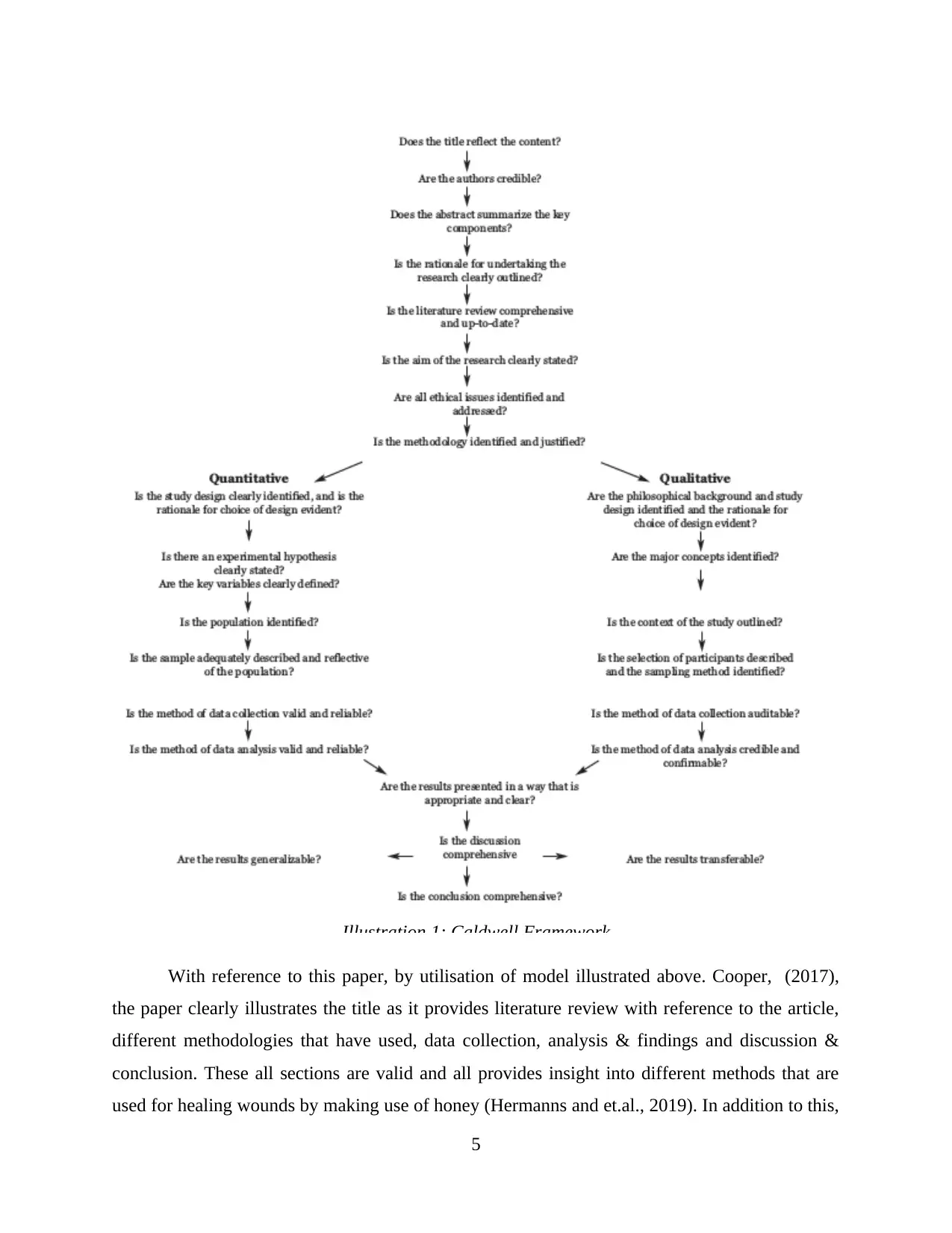
With reference to this paper, by utilisation of model illustrated above. Cooper, (2017),
the paper clearly illustrates the title as it provides literature review with reference to the article,
different methodologies that have used, data collection, analysis & findings and discussion &
conclusion. These all sections are valid and all provides insight into different methods that are
used for healing wounds by making use of honey (Hermanns and et.al., 2019). In addition to this,
5
Illustration 1: Caldwell Framework
the paper clearly illustrates the title as it provides literature review with reference to the article,
different methodologies that have used, data collection, analysis & findings and discussion &
conclusion. These all sections are valid and all provides insight into different methods that are
used for healing wounds by making use of honey (Hermanns and et.al., 2019). In addition to this,
5
Illustration 1: Caldwell Framework
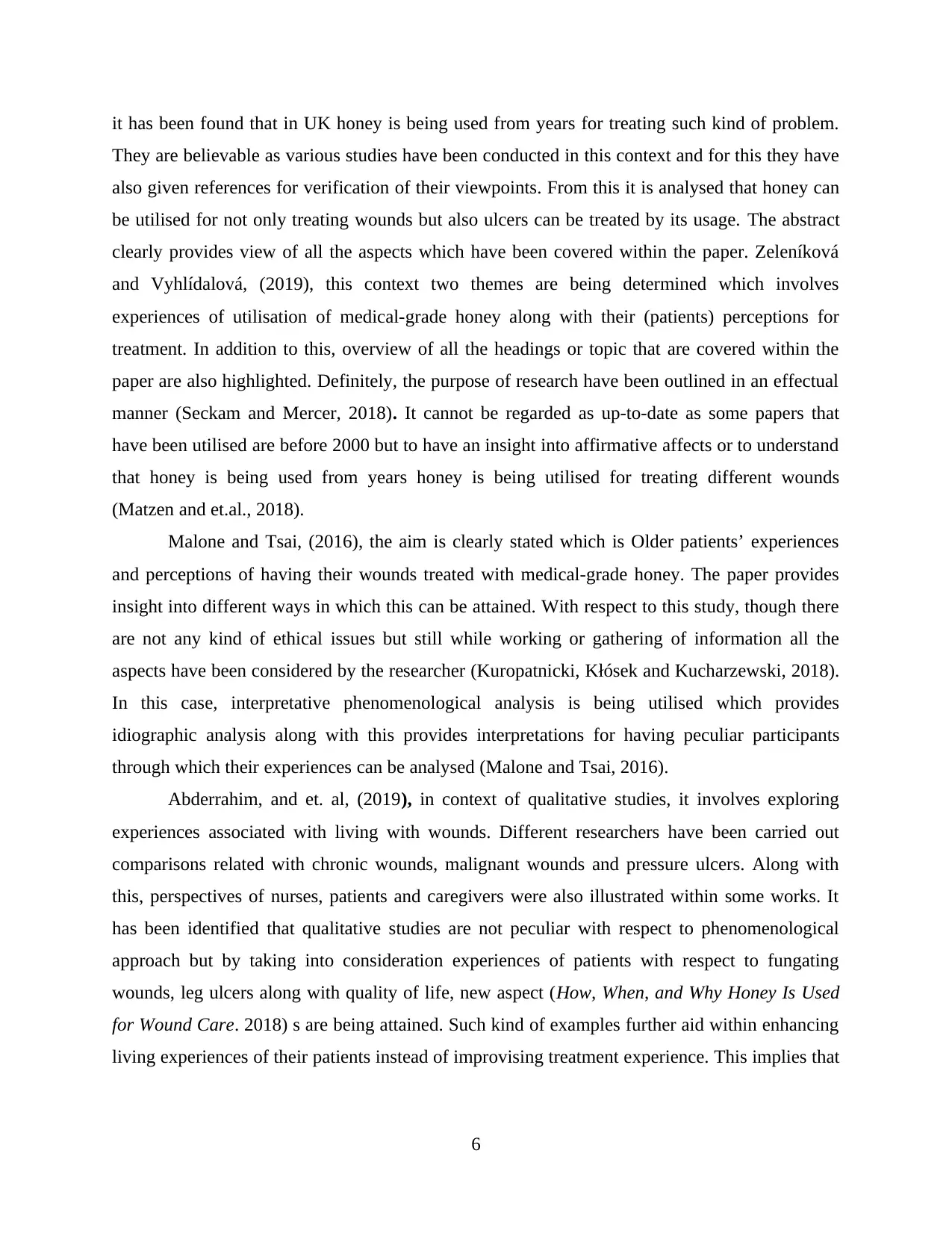
it has been found that in UK honey is being used from years for treating such kind of problem.
They are believable as various studies have been conducted in this context and for this they have
also given references for verification of their viewpoints. From this it is analysed that honey can
be utilised for not only treating wounds but also ulcers can be treated by its usage. The abstract
clearly provides view of all the aspects which have been covered within the paper. Zeleníková
and Vyhlídalová, (2019), this context two themes are being determined which involves
experiences of utilisation of medical-grade honey along with their (patients) perceptions for
treatment. In addition to this, overview of all the headings or topic that are covered within the
paper are also highlighted. Definitely, the purpose of research have been outlined in an effectual
manner (Seckam and Mercer, 2018). It cannot be regarded as up-to-date as some papers that
have been utilised are before 2000 but to have an insight into affirmative affects or to understand
that honey is being used from years honey is being utilised for treating different wounds
(Matzen and et.al., 2018).
Malone and Tsai, (2016), the aim is clearly stated which is Older patients’ experiences
and perceptions of having their wounds treated with medical-grade honey. The paper provides
insight into different ways in which this can be attained. With respect to this study, though there
are not any kind of ethical issues but still while working or gathering of information all the
aspects have been considered by the researcher (Kuropatnicki, Kłósek and Kucharzewski, 2018).
In this case, interpretative phenomenological analysis is being utilised which provides
idiographic analysis along with this provides interpretations for having peculiar participants
through which their experiences can be analysed (Malone and Tsai, 2016).
Abderrahim, and et. al, (2019), in context of qualitative studies, it involves exploring
experiences associated with living with wounds. Different researchers have been carried out
comparisons related with chronic wounds, malignant wounds and pressure ulcers. Along with
this, perspectives of nurses, patients and caregivers were also illustrated within some works. It
has been identified that qualitative studies are not peculiar with respect to phenomenological
approach but by taking into consideration experiences of patients with respect to fungating
wounds, leg ulcers along with quality of life, new aspect (How, When, and Why Honey Is Used
for Wound Care. 2018) s are being attained. Such kind of examples further aid within enhancing
living experiences of their patients instead of improvising treatment experience. This implies that
6
They are believable as various studies have been conducted in this context and for this they have
also given references for verification of their viewpoints. From this it is analysed that honey can
be utilised for not only treating wounds but also ulcers can be treated by its usage. The abstract
clearly provides view of all the aspects which have been covered within the paper. Zeleníková
and Vyhlídalová, (2019), this context two themes are being determined which involves
experiences of utilisation of medical-grade honey along with their (patients) perceptions for
treatment. In addition to this, overview of all the headings or topic that are covered within the
paper are also highlighted. Definitely, the purpose of research have been outlined in an effectual
manner (Seckam and Mercer, 2018). It cannot be regarded as up-to-date as some papers that
have been utilised are before 2000 but to have an insight into affirmative affects or to understand
that honey is being used from years honey is being utilised for treating different wounds
(Matzen and et.al., 2018).
Malone and Tsai, (2016), the aim is clearly stated which is Older patients’ experiences
and perceptions of having their wounds treated with medical-grade honey. The paper provides
insight into different ways in which this can be attained. With respect to this study, though there
are not any kind of ethical issues but still while working or gathering of information all the
aspects have been considered by the researcher (Kuropatnicki, Kłósek and Kucharzewski, 2018).
In this case, interpretative phenomenological analysis is being utilised which provides
idiographic analysis along with this provides interpretations for having peculiar participants
through which their experiences can be analysed (Malone and Tsai, 2016).
Abderrahim, and et. al, (2019), in context of qualitative studies, it involves exploring
experiences associated with living with wounds. Different researchers have been carried out
comparisons related with chronic wounds, malignant wounds and pressure ulcers. Along with
this, perspectives of nurses, patients and caregivers were also illustrated within some works. It
has been identified that qualitative studies are not peculiar with respect to phenomenological
approach but by taking into consideration experiences of patients with respect to fungating
wounds, leg ulcers along with quality of life, new aspect (How, When, and Why Honey Is Used
for Wound Care. 2018) s are being attained. Such kind of examples further aid within enhancing
living experiences of their patients instead of improvising treatment experience. This implies that
6
⊘ This is a preview!⊘
Do you want full access?
Subscribe today to unlock all pages.

Trusted by 1+ million students worldwide
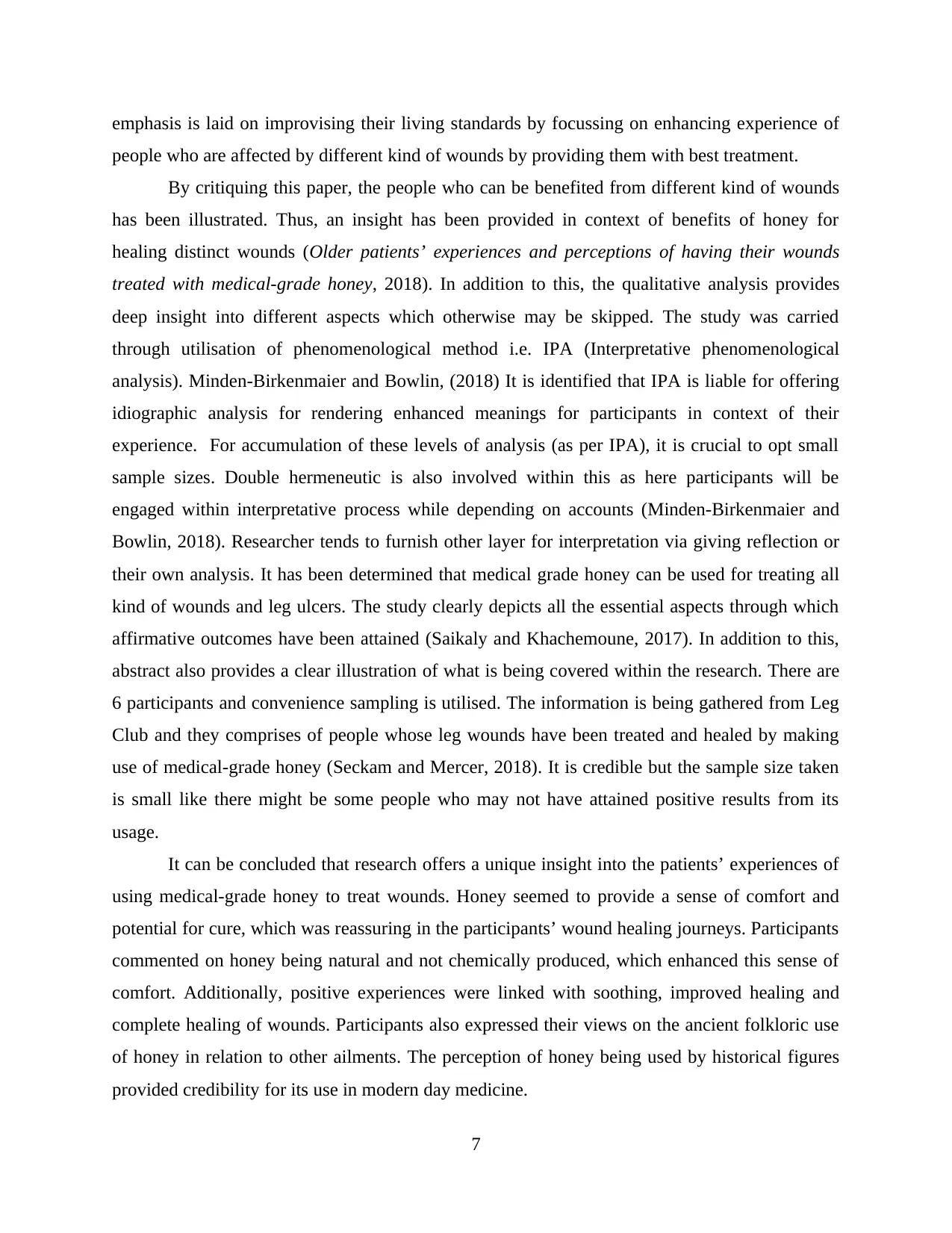
emphasis is laid on improvising their living standards by focussing on enhancing experience of
people who are affected by different kind of wounds by providing them with best treatment.
By critiquing this paper, the people who can be benefited from different kind of wounds
has been illustrated. Thus, an insight has been provided in context of benefits of honey for
healing distinct wounds (Older patients’ experiences and perceptions of having their wounds
treated with medical-grade honey, 2018). In addition to this, the qualitative analysis provides
deep insight into different aspects which otherwise may be skipped. The study was carried
through utilisation of phenomenological method i.e. IPA (Interpretative phenomenological
analysis). Minden-Birkenmaier and Bowlin, (2018) It is identified that IPA is liable for offering
idiographic analysis for rendering enhanced meanings for participants in context of their
experience. For accumulation of these levels of analysis (as per IPA), it is crucial to opt small
sample sizes. Double hermeneutic is also involved within this as here participants will be
engaged within interpretative process while depending on accounts (Minden-Birkenmaier and
Bowlin, 2018). Researcher tends to furnish other layer for interpretation via giving reflection or
their own analysis. It has been determined that medical grade honey can be used for treating all
kind of wounds and leg ulcers. The study clearly depicts all the essential aspects through which
affirmative outcomes have been attained (Saikaly and Khachemoune, 2017). In addition to this,
abstract also provides a clear illustration of what is being covered within the research. There are
6 participants and convenience sampling is utilised. The information is being gathered from Leg
Club and they comprises of people whose leg wounds have been treated and healed by making
use of medical-grade honey (Seckam and Mercer, 2018). It is credible but the sample size taken
is small like there might be some people who may not have attained positive results from its
usage.
It can be concluded that research offers a unique insight into the patients’ experiences of
using medical-grade honey to treat wounds. Honey seemed to provide a sense of comfort and
potential for cure, which was reassuring in the participants’ wound healing journeys. Participants
commented on honey being natural and not chemically produced, which enhanced this sense of
comfort. Additionally, positive experiences were linked with soothing, improved healing and
complete healing of wounds. Participants also expressed their views on the ancient folkloric use
of honey in relation to other ailments. The perception of honey being used by historical figures
provided credibility for its use in modern day medicine.
7
people who are affected by different kind of wounds by providing them with best treatment.
By critiquing this paper, the people who can be benefited from different kind of wounds
has been illustrated. Thus, an insight has been provided in context of benefits of honey for
healing distinct wounds (Older patients’ experiences and perceptions of having their wounds
treated with medical-grade honey, 2018). In addition to this, the qualitative analysis provides
deep insight into different aspects which otherwise may be skipped. The study was carried
through utilisation of phenomenological method i.e. IPA (Interpretative phenomenological
analysis). Minden-Birkenmaier and Bowlin, (2018) It is identified that IPA is liable for offering
idiographic analysis for rendering enhanced meanings for participants in context of their
experience. For accumulation of these levels of analysis (as per IPA), it is crucial to opt small
sample sizes. Double hermeneutic is also involved within this as here participants will be
engaged within interpretative process while depending on accounts (Minden-Birkenmaier and
Bowlin, 2018). Researcher tends to furnish other layer for interpretation via giving reflection or
their own analysis. It has been determined that medical grade honey can be used for treating all
kind of wounds and leg ulcers. The study clearly depicts all the essential aspects through which
affirmative outcomes have been attained (Saikaly and Khachemoune, 2017). In addition to this,
abstract also provides a clear illustration of what is being covered within the research. There are
6 participants and convenience sampling is utilised. The information is being gathered from Leg
Club and they comprises of people whose leg wounds have been treated and healed by making
use of medical-grade honey (Seckam and Mercer, 2018). It is credible but the sample size taken
is small like there might be some people who may not have attained positive results from its
usage.
It can be concluded that research offers a unique insight into the patients’ experiences of
using medical-grade honey to treat wounds. Honey seemed to provide a sense of comfort and
potential for cure, which was reassuring in the participants’ wound healing journeys. Participants
commented on honey being natural and not chemically produced, which enhanced this sense of
comfort. Additionally, positive experiences were linked with soothing, improved healing and
complete healing of wounds. Participants also expressed their views on the ancient folkloric use
of honey in relation to other ailments. The perception of honey being used by historical figures
provided credibility for its use in modern day medicine.
7
Paraphrase This Document
Need a fresh take? Get an instant paraphrase of this document with our AI Paraphraser
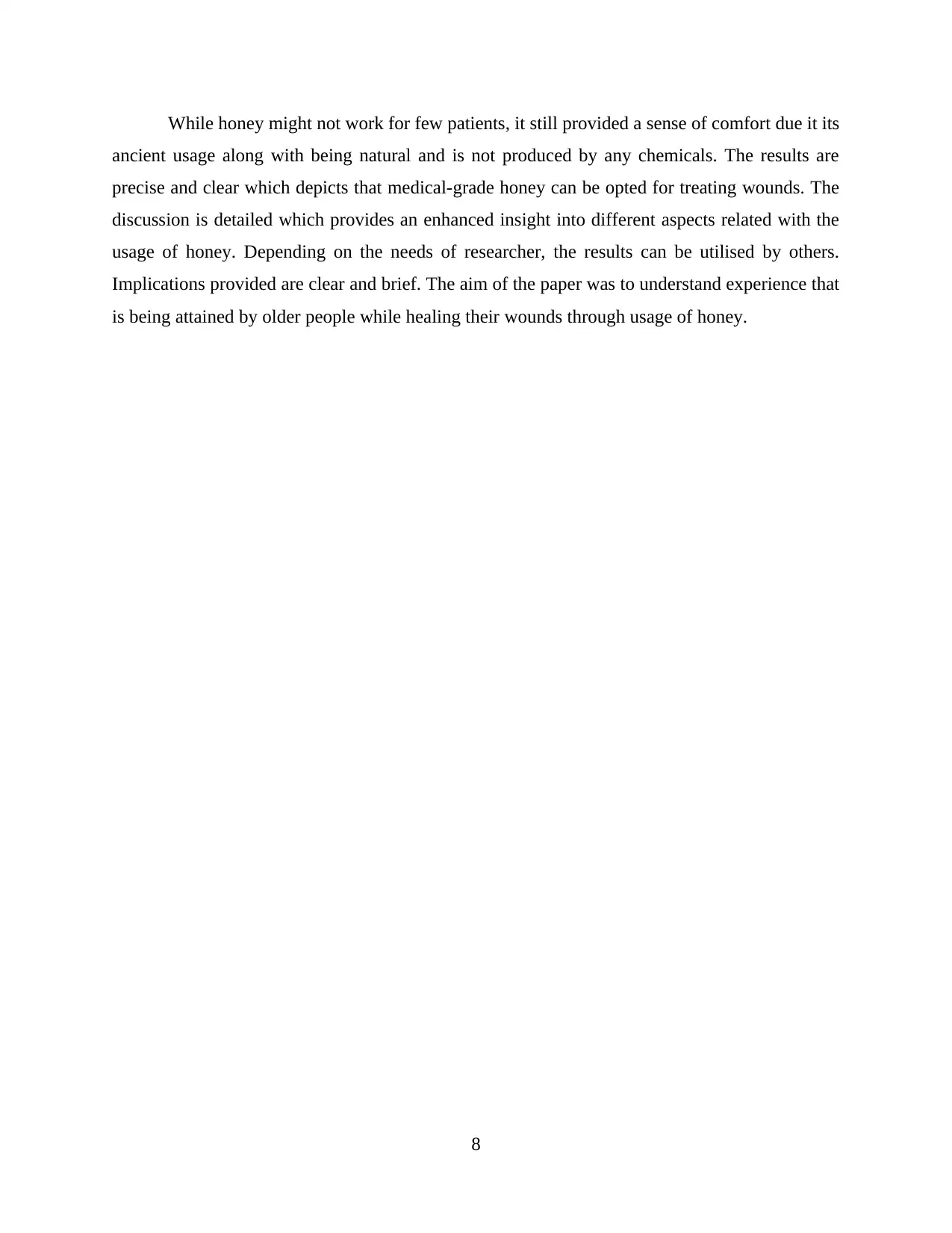
While honey might not work for few patients, it still provided a sense of comfort due it its
ancient usage along with being natural and is not produced by any chemicals. The results are
precise and clear which depicts that medical-grade honey can be opted for treating wounds. The
discussion is detailed which provides an enhanced insight into different aspects related with the
usage of honey. Depending on the needs of researcher, the results can be utilised by others.
Implications provided are clear and brief. The aim of the paper was to understand experience that
is being attained by older people while healing their wounds through usage of honey.
8
ancient usage along with being natural and is not produced by any chemicals. The results are
precise and clear which depicts that medical-grade honey can be opted for treating wounds. The
discussion is detailed which provides an enhanced insight into different aspects related with the
usage of honey. Depending on the needs of researcher, the results can be utilised by others.
Implications provided are clear and brief. The aim of the paper was to understand experience that
is being attained by older people while healing their wounds through usage of honey.
8
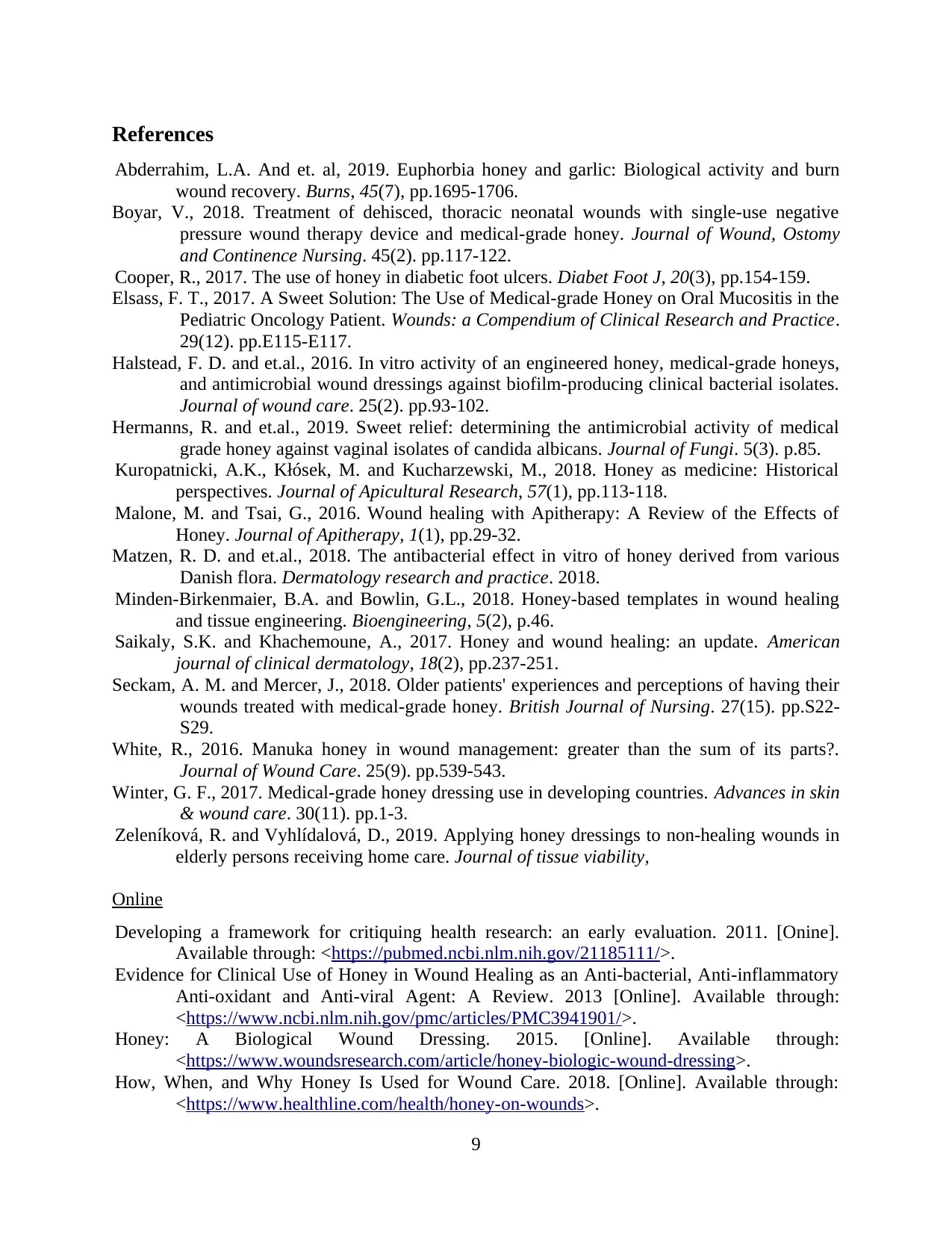
References
Abderrahim, L.A. And et. al, 2019. Euphorbia honey and garlic: Biological activity and burn
wound recovery. Burns, 45(7), pp.1695-1706.
Boyar, V., 2018. Treatment of dehisced, thoracic neonatal wounds with single-use negative
pressure wound therapy device and medical-grade honey. Journal of Wound, Ostomy
and Continence Nursing. 45(2). pp.117-122.
Cooper, R., 2017. The use of honey in diabetic foot ulcers. Diabet Foot J, 20(3), pp.154-159.
Elsass, F. T., 2017. A Sweet Solution: The Use of Medical-grade Honey on Oral Mucositis in the
Pediatric Oncology Patient. Wounds: a Compendium of Clinical Research and Practice.
29(12). pp.E115-E117.
Halstead, F. D. and et.al., 2016. In vitro activity of an engineered honey, medical-grade honeys,
and antimicrobial wound dressings against biofilm-producing clinical bacterial isolates.
Journal of wound care. 25(2). pp.93-102.
Hermanns, R. and et.al., 2019. Sweet relief: determining the antimicrobial activity of medical
grade honey against vaginal isolates of candida albicans. Journal of Fungi. 5(3). p.85.
Kuropatnicki, A.K., Kłósek, M. and Kucharzewski, M., 2018. Honey as medicine: Historical
perspectives. Journal of Apicultural Research, 57(1), pp.113-118.
Malone, M. and Tsai, G., 2016. Wound healing with Apitherapy: A Review of the Effects of
Honey. Journal of Apitherapy, 1(1), pp.29-32.
Matzen, R. D. and et.al., 2018. The antibacterial effect in vitro of honey derived from various
Danish flora. Dermatology research and practice. 2018.
Minden-Birkenmaier, B.A. and Bowlin, G.L., 2018. Honey-based templates in wound healing
and tissue engineering. Bioengineering, 5(2), p.46.
Saikaly, S.K. and Khachemoune, A., 2017. Honey and wound healing: an update. American
journal of clinical dermatology, 18(2), pp.237-251.
Seckam, A. M. and Mercer, J., 2018. Older patients' experiences and perceptions of having their
wounds treated with medical-grade honey. British Journal of Nursing. 27(15). pp.S22-
S29.
White, R., 2016. Manuka honey in wound management: greater than the sum of its parts?.
Journal of Wound Care. 25(9). pp.539-543.
Winter, G. F., 2017. Medical-grade honey dressing use in developing countries. Advances in skin
& wound care. 30(11). pp.1-3.
Zeleníková, R. and Vyhlídalová, D., 2019. Applying honey dressings to non-healing wounds in
elderly persons receiving home care. Journal of tissue viability,
Online
Developing a framework for critiquing health research: an early evaluation. 2011. [Onine].
Available through: <https://pubmed.ncbi.nlm.nih.gov/21185111/>.
Evidence for Clinical Use of Honey in Wound Healing as an Anti-bacterial, Anti-inflammatory
Anti-oxidant and Anti-viral Agent: A Review. 2013 [Online]. Available through:
<https://www.ncbi.nlm.nih.gov/pmc/articles/PMC3941901/>.
Honey: A Biological Wound Dressing. 2015. [Online]. Available through:
<https://www.woundsresearch.com/article/honey-biologic-wound-dressing>.
How, When, and Why Honey Is Used for Wound Care. 2018. [Online]. Available through:
<https://www.healthline.com/health/honey-on-wounds>.
9
Abderrahim, L.A. And et. al, 2019. Euphorbia honey and garlic: Biological activity and burn
wound recovery. Burns, 45(7), pp.1695-1706.
Boyar, V., 2018. Treatment of dehisced, thoracic neonatal wounds with single-use negative
pressure wound therapy device and medical-grade honey. Journal of Wound, Ostomy
and Continence Nursing. 45(2). pp.117-122.
Cooper, R., 2017. The use of honey in diabetic foot ulcers. Diabet Foot J, 20(3), pp.154-159.
Elsass, F. T., 2017. A Sweet Solution: The Use of Medical-grade Honey on Oral Mucositis in the
Pediatric Oncology Patient. Wounds: a Compendium of Clinical Research and Practice.
29(12). pp.E115-E117.
Halstead, F. D. and et.al., 2016. In vitro activity of an engineered honey, medical-grade honeys,
and antimicrobial wound dressings against biofilm-producing clinical bacterial isolates.
Journal of wound care. 25(2). pp.93-102.
Hermanns, R. and et.al., 2019. Sweet relief: determining the antimicrobial activity of medical
grade honey against vaginal isolates of candida albicans. Journal of Fungi. 5(3). p.85.
Kuropatnicki, A.K., Kłósek, M. and Kucharzewski, M., 2018. Honey as medicine: Historical
perspectives. Journal of Apicultural Research, 57(1), pp.113-118.
Malone, M. and Tsai, G., 2016. Wound healing with Apitherapy: A Review of the Effects of
Honey. Journal of Apitherapy, 1(1), pp.29-32.
Matzen, R. D. and et.al., 2018. The antibacterial effect in vitro of honey derived from various
Danish flora. Dermatology research and practice. 2018.
Minden-Birkenmaier, B.A. and Bowlin, G.L., 2018. Honey-based templates in wound healing
and tissue engineering. Bioengineering, 5(2), p.46.
Saikaly, S.K. and Khachemoune, A., 2017. Honey and wound healing: an update. American
journal of clinical dermatology, 18(2), pp.237-251.
Seckam, A. M. and Mercer, J., 2018. Older patients' experiences and perceptions of having their
wounds treated with medical-grade honey. British Journal of Nursing. 27(15). pp.S22-
S29.
White, R., 2016. Manuka honey in wound management: greater than the sum of its parts?.
Journal of Wound Care. 25(9). pp.539-543.
Winter, G. F., 2017. Medical-grade honey dressing use in developing countries. Advances in skin
& wound care. 30(11). pp.1-3.
Zeleníková, R. and Vyhlídalová, D., 2019. Applying honey dressings to non-healing wounds in
elderly persons receiving home care. Journal of tissue viability,
Online
Developing a framework for critiquing health research: an early evaluation. 2011. [Onine].
Available through: <https://pubmed.ncbi.nlm.nih.gov/21185111/>.
Evidence for Clinical Use of Honey in Wound Healing as an Anti-bacterial, Anti-inflammatory
Anti-oxidant and Anti-viral Agent: A Review. 2013 [Online]. Available through:
<https://www.ncbi.nlm.nih.gov/pmc/articles/PMC3941901/>.
Honey: A Biological Wound Dressing. 2015. [Online]. Available through:
<https://www.woundsresearch.com/article/honey-biologic-wound-dressing>.
How, When, and Why Honey Is Used for Wound Care. 2018. [Online]. Available through:
<https://www.healthline.com/health/honey-on-wounds>.
9
⊘ This is a preview!⊘
Do you want full access?
Subscribe today to unlock all pages.

Trusted by 1+ million students worldwide
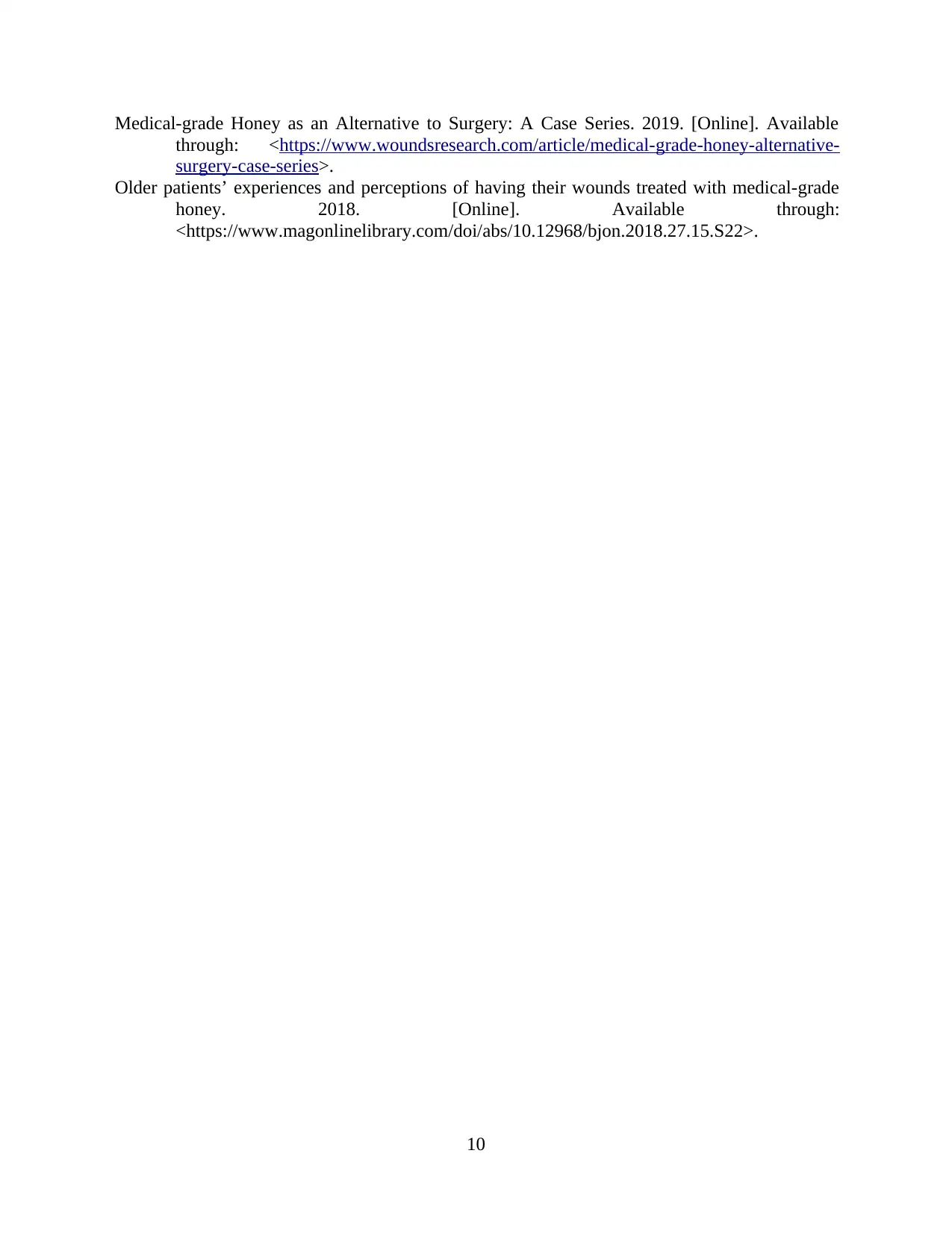
Medical-grade Honey as an Alternative to Surgery: A Case Series. 2019. [Online]. Available
through: <https://www.woundsresearch.com/article/medical-grade-honey-alternative-
surgery-case-series>.
Older patients’ experiences and perceptions of having their wounds treated with medical-grade
honey. 2018. [Online]. Available through:
<https://www.magonlinelibrary.com/doi/abs/10.12968/bjon.2018.27.15.S22>.
10
through: <https://www.woundsresearch.com/article/medical-grade-honey-alternative-
surgery-case-series>.
Older patients’ experiences and perceptions of having their wounds treated with medical-grade
honey. 2018. [Online]. Available through:
<https://www.magonlinelibrary.com/doi/abs/10.12968/bjon.2018.27.15.S22>.
10
1 out of 10
Your All-in-One AI-Powered Toolkit for Academic Success.
+13062052269
info@desklib.com
Available 24*7 on WhatsApp / Email
![[object Object]](/_next/static/media/star-bottom.7253800d.svg)
Unlock your academic potential
Copyright © 2020–2025 A2Z Services. All Rights Reserved. Developed and managed by ZUCOL.


